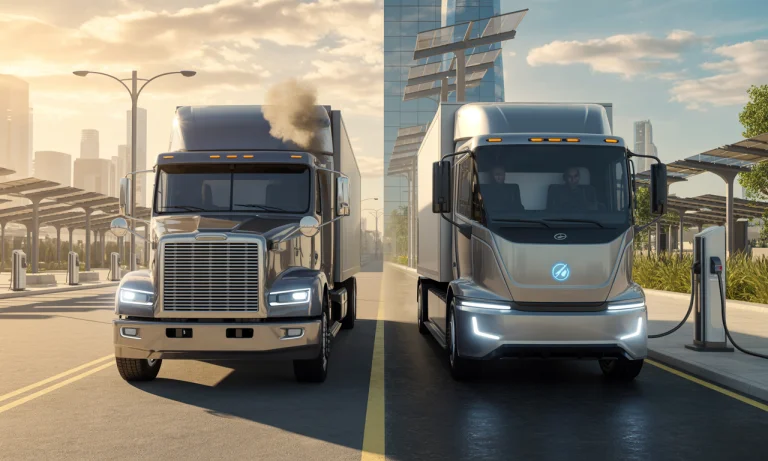Every crossroads in transportation history has its turning point—a moment when innovation collides with necessity, and a new era begins. In 2025, the debate between diesel and electric trucks is no longer confined to manufacturers’ showrooms or policy roundtables; it’s playing out on highways, loading docks, and fleet management offices around the globe. Legendary names like Ford, Chevrolet, Ram, Tesla, Rivian, GMC, Freightliner, Nikola, Volvo, and Peterbilt now battle for dominance, each staking its future on different visions of power, cost, and sustainability. Amid falling battery prices, ever-tightening emissions regulations, and mounting evidence of climate urgency, businesses and drivers are forced to ask: which choice truly leads the way forward? The answers, as companies retool their fleets and governments reshape their incentives, drive a narrative as dynamic as the journeys these vehicles undertake. For businesses betting on the next decade, the question isn’t if change is coming—it’s how fast it will transform the road ahead.
Electric Truck Performance vs Diesel: Torque, Efficiency, and Real-World Lessons
The archetype of the diesel workhorse—endlessly rumbling from coast to coast—faces its first serious challenger in decades. Urban distribution hubs are abuzz as new electric models from Ford and Tesla promise instant torque and near-silent operation. For regional hauls, the 2025 GMC electric rig launches with acceleration that would surprise even the most loyal diesel driver. Operators like Janelle, who manages a multi-state fleet, watched as her maintenance bills plummeted when a portion of her fleet converted to electric: “Our trucks are in and out of the shop less. Brakes last longer. Unexpected repairs have practically disappeared.”
The efficiency gap is clear in the data. Electric drivetrains convert stored energy into motion with a higher degree of efficiency than internal combustion engines ever could. However, for epic cross-country trips, models like the Freightliner Cascadia diesel still have the edge—thanks to established fueling infrastructure and the unmatched speed of diesel refueling. As charging times shrink with next-gen battery technology, the ground shifts. Industry predictions suggest parity in many trucking segments by decade’s end.
| Performance Metric | Diesel Truck | Electric Truck |
|---|---|---|
| Instant Torque | Medium (Delayed) | High (Immediate) |
| Range (Long Haul) | Up to 1,200 miles | Up to 500 miles (expanding fast) |
| Refueling/Charging Time | 15 min | 45 min – 2 hours (improving fast) |
| Maintenance Frequency | High | Low |
Cost Comparison: Lifetime Savings and Upfront Barriers
When Janelle evaluated vehicle replacement options in 2025, sticker shock was instant: electric trucks demanded 10 to 20% more upfront. Yet, a closer study—mirrored in recent economic analyses—revealed a shifting landscape. The real difference emerges in total cost of ownership, where electric trucks now routinely undercut diesel over time, especially in urban and mid-range settings. Falling battery costs (an 86% drop for lithium iron phosphate units since 2013) combined with reduced fuel and maintenance needs tilt the balance. Diesel’s only remaining shield? Long-haul dominance, where battery infrastructure and range still lag—even as cities and governments ramp up fast-charging corridors.
| Cost Factor | Diesel | Electric |
|---|---|---|
| Initial Purchase | Lower | Higher |
| Fuel/Energy Cost | High & Fluctuating | Low & Stable |
| Lifetime Maintenance | Significant | Minor |
| Lifetime Cost (Urban Fleet) | $250,000+ | $200,000 or less |
Emissions, Health, and the Push for Cleaner Roads
The legacy of diesel trucks isn’t only one of economic might. Their role in air quality and health, especially in urban corridors, cannot be ignored. City after city reports that pollution from heavy-duty traffic—still largely diesel—remains a top environmental concern. Electric trucks, from the nimble Rivian delivery van to mammoth Volvo tractors, now arrive offering more than just efficiency: they promise quieter neighborhoods and fewer hospital visits for ailments linked to emissions. According to recent research, a swift transition to e-trucks could curb deaths caused by transport pollution—a figure estimated at nearly 400,000 per year worldwide. Switching fleets may rest on economics, but the benefits spill far past balance sheets, boosting both local quality of life and global climate efforts.
Policy, Incentives, and the New Competitive Roadmap
Narratives of technological change always run parallel with policy. The story of 2025 is no different. Regulatory anchors—zero-emission mandates, rigorous fleet-wide CO₂ standards, and targeted incentives—now drive the adoption of electric behemoths as much as engineering breakthroughs. The right policy cocktail, as demonstrated in China and major European cities, brings the cost tipping point forward by years. In places where mandates are enforced, even skeptical operators of Peterbilt or Chevrolet diesels admit the economics are hard to ignore. Meanwhile, subsidies sweeten the deal for early adopters, though their real power lies in supporting markets once initial demand is achieved. Curious about legislative trends? Dive into the latest coverage on next-gen vehicle policy at LeftLaneNews or trace advancements in vehicle tech and regulation.
| Region | Effective Policy Tool | Impact on Truck Electrification |
|---|---|---|
| China | Mandates & Subsidies | Rapid Uptake |
| Europe | CO₂ Standards | Accelerated Adoption |
| US | Emissions Targets, Incentives | Steady Growth |
Chasing lower emissions and better fiscal horizons, operators who once swore by Ram diesels now watch the progress of both Tesla Semi and Nikola Tre with cautious optimism. The experience of early adopters becomes, itself, a tool for driving market confidence—and change.
Explore more on future electric vehicle trends and meet the LeftLaneNews team reporting from the frontlines of automotive innovation.
Fleet Evolution: Infrastructure Hurdles and Market Acceleration
For all the promise of electrification, the logistics equation isn’t solved yet. Charging infrastructure must expand at warp speed to realize the full potential of electric models. Market leaders like Volvo and Nikola collaborate with energy providers to ensure charging grids keep pace with fleets, but grid bottlenecks and location gaps can delay the transition for rural or long-haul operators. Investment here becomes the silent force determining whether electric trucks remain a city phenomenon or conquer national highways. Stories of creative workarounds—like mobile charging stations or solar-augmented depots—dot the map, signaling that while challenges are real, so too is innovation.
With manufacturers boasting hundreds of new electric models, and policies unlocking demand, the road is set—what remains is the pace and shape of transformation. Industry insiders share, off the record, that even the most conservative fleets budget for electrification by 2030, driven less by mandates than by competitive cost pressure.
Your Questions Answered About Diesel vs Electric Trucks in 2025
Do electric trucks really save money over diesel in the long run?
Yes, especially in urban and regional operations. Despite higher upfront costs, electric trucks’ lower energy and maintenance expenses typically make them cheaper across their initial lifetime. Upfront incentives and rapidly dropping battery prices amplify those savings. For a detailed breakdown, check recent reports on cost efficiency.
Where are electric trucks already cheaper to own than diesel?
Data shows that regions like China and select European countries have reached or are nearing the tipping point, mainly for heavy and medium-duty trucks. Cities with emission mandates and robust infrastructure see the fastest transition—some fleets are already almost fully electric.
Which manufacturers are leading in electric truck innovation for 2025?
Iconic brands such as Tesla, Rivian, Nikola, Ford, Chevrolet, GMC, Freightliner, Volvo, and Peterbilt are at the forefront. Their new releases frequently make headlines for breakthroughs in range, power, and integrated tech.
Are diesel trucks still better for long-haul routes?
As of now, diesel maintains an edge for extended, cross-country routes, thanks to established fuel networks and superior range. But major advances in battery tech and charging networks are quickly closing the gap.
How important are government policies in accelerating electric truck adoption?
Crucial. Zero-emission mandates and targeted incentives have consistently been the most effective levers for change, often speeding transition timelines by several years. For deep dives on policy effectiveness, explore more at LeftLaneNews policy hub.
Did you like it? 4.7/5 (21)







